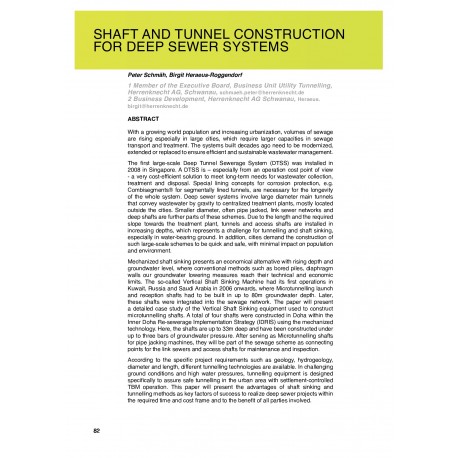Cart
0
0
No document
0,00 €
Total
Document successfully added to your shopping cart
Quantity
Total
There are 0 items in your cart.
There is 1 item in your cart.
Total documents
Total shipping
To be determined
Total
Search & filter
Search for a publication
Search & filter
Viewed documents
Shaft and tunnel construction for deep sewer systems
3763_shaft_and_tunnel_constructi
P. Schmäh / B. Heraeus-Roggendorf
With a growing world population and increasing urbanization, volumes of sewage are rising especially in large cities, which require larger capacities in sewage transport and treatment. The systems built decades ago need to be modernized, extended or replaced to ensure efficient and sustainable wastewater management.The first large-scale Deep Tunnel Sewerage System (DTSS) was installed in 2008 in Singapore. A DTSS is – especially from an operation cost point of view - a very cost-efficient solution to meet long-term needs for wastewater collection, treatment and disposal. Special lining concepts for corrosion protection, e.g. Combisegments® for segmentally lined tunnels, are necessary for the longevity of the whole system. Deep sewer systems involve large diameter main tunnels that convey wastewater by gravity to centralized treatment plants, mostly located outside the cities. Smaller diameter, often pipe jacked, link sewer networks and deep shafts are further parts of these schemes. Due to the length and the required slope towards the treatment plant, tunnels and access shafts are installed in increasing depths, which represents a challenge for tunnelling and shaft sinking, especially in water-bearing ground. In addition, cities demand the construction of such large-scale schemes to be quick and safe, with minimal impact on population and environment.Mechanized shaft sinking presents an economical alternative with rising depth and groundwater level, where conventional methods such as bored piles, diaphragm walls our groundwater lowering measures reach their technical and economic limits. The so-called Vertical Shaft Sinking Machine had its first operations in Kuwait, Russia and Saudi Arabia in 2006 onwards, where Microtunnelling launch and reception shafts had to be built in up to 80m groundwater depth. Later, these shafts were integrated into the sewage network. The paper will present a detailed case study of the Vertical Shaft Sinking equipment used to construct microtunnelling shafts. A total of four shafts were constructed in Doha within the Inner Doha Re-sewerage Implementation Strategy (IDRIS) using the mechanized technology. Here, the shafts are up to 33m deep and have been constructed under up to three bars of groundwater pressure. After serving as Microtunnelling shafts for pipe jacking machines, they will be part of the sewage scheme as connecting points for the link sewers and access shafts for maintenance and inspection.According to the specific project requirements such as geology, hydrogeology, diameter and length, different tunnelling technologies are available. In challenging ground conditions and high water pressures, tunnelling equipment is designed specifically to assure safe tunnelling in the urban area with settlement-controlled TBM operation.




